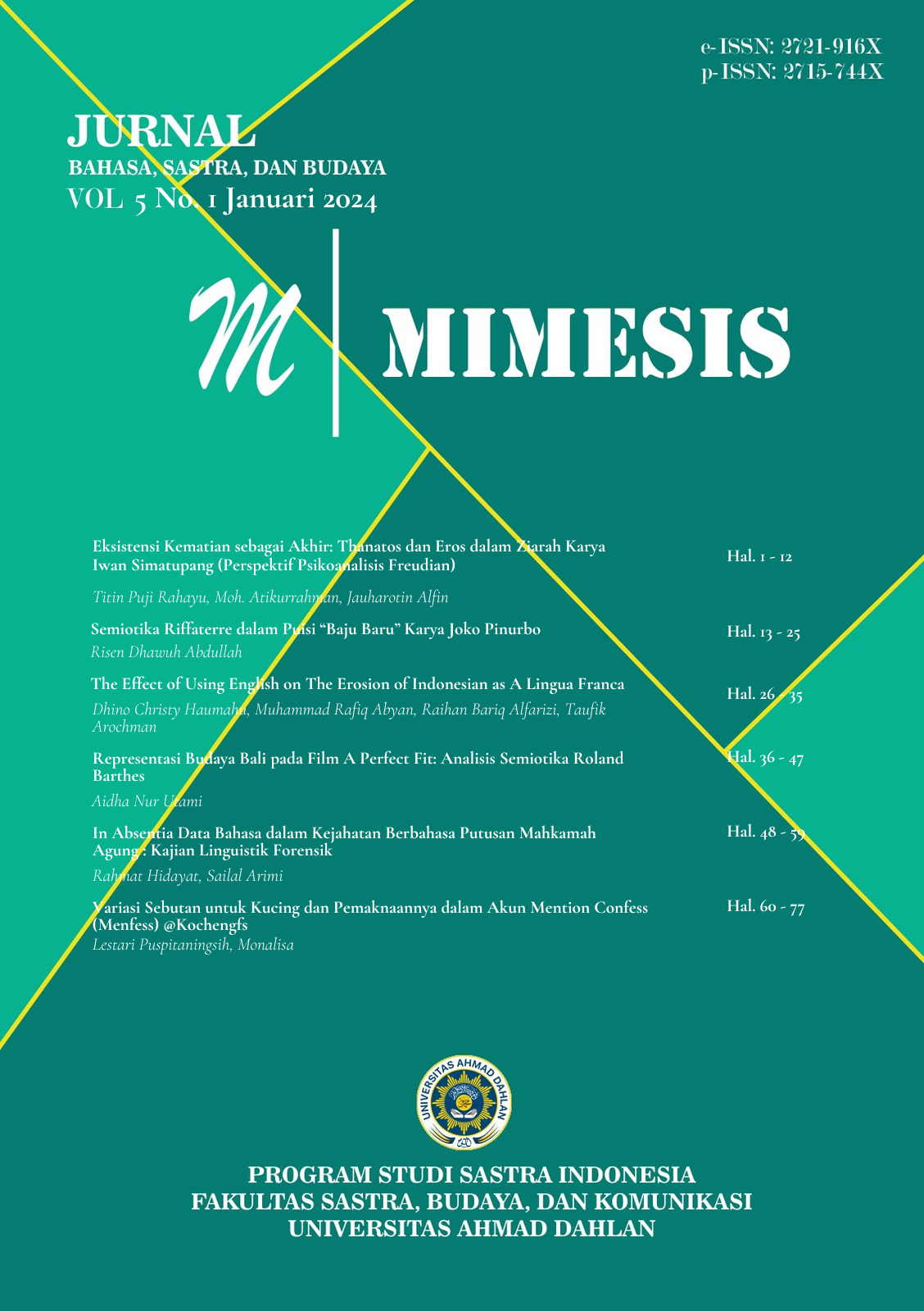Eksistensi Kematian sebagai Akhir: Thanatos dan Eros dalam Ziarah Karya Iwan Simatupang (Perspektif Psikoanalisis Freudian)
DOI:
https://doi.org/10.12928/mms.v5i1.7799Keywords:
Psychoanalysis, Personality Dynamics, Sigmund Freud, Ziarah NovelsAbstract
This article explores personality dynamics in Indonesian literature by taking the theme of death in the novel Ziarah by Iwan Simatupang (1969). The concept of 'Thanatos and Eros' from Freudian psychoanalytic research is understood as the relationship between instincts in human behavior, which are described as conflicting settings, namely the death instinct and the life instinct. This research uses a qualitative description method and a content analysis method in the form of presenting data in the form of words and sentences taken from the novel Ziarah by Iwan Simatupang (1969) on the aspects of Thanatos (death instinct), eros (life instinct) and anxitas (anxiety). The research techniques used are literature review, note-taking, and data processing techniques. Thus, research into personality dynamics in the novel Ziarah by Iwan Simatupang obtained six data on Thanatos (death instinct), five data on eros (life instinct), and one data on anxitas (anxiety). Thanatos (death instinct) data emphasizes the death instinct in the form of aggression and suicidal actions in the Painter character, the Young and Old Operative character, and the Mayor character. The eros data (life instinct) emphasizes the sexual instinct in the painter's characters and the non-sexual instinct (lamentation poetry) in fulfilling physical needs such as feelings of hunger, thirst, work, and others. Anxiety data emphasizes the anxiety of death in the painter's character.
References
Arianto, F. (2021). Tinjauan Psikologi Tokoh Pada Naskah Drama Bulan Bujur Sangkar Karya Iwan Simatupang. BASINDO : jurnal kajian bahasa, sastra Indonesia, dan pembelajarannya, 5(2), Art. 2.
Bakri, M. (2018). Dialog Polifonik Dalam Novel Ziarah Karya Iwan Simatupang (Tinjauan Dialogis Mikhail Bakhtin). 8.
Faishal, A. (2022). Kematian Di Atas Panggung Eksperimental: Dekonstruksi dalam Naskah Lakon RE Karya Akhudiat. SULUK: Jurnal Bahasa, Sastra, Dan Budaya, 4(1), Art. 1. https://doi.org/10.15642/suluk.2022.4.1.34-46
Harahap, Y. H., & Wijaksana, M. R. (2021). Analisis Tindak Tutur Lokusi, Ilokusi, dan Perlokusi Dalam Naskah Drama “Bulan Bujur Sangkar” Karya Iwan Simatupang. PROSIDING SAMASTA, 0, Art. 0.
Kadaryati, & Pradopo, R. D. (2004). Unsur bawah sadar tokoh Merahnya Merah Iwan Simatupang pemaknaan dengan kajian psikoanalisis [Universitas Gadjah Mada]. http://etd.repository.ugm.ac.id/penelitian/detail/25676
Minderop, A. (2010). Psikologi Sastra: Karya, Metode, Teori, dan Contoh Kasus. Yayasan Pustaka Obor Indonesia.
Mufti, M. M. A., & Anita, A. (2022). Kepribadian Tokoh dalam Naskah Drama Bulan Bujur Sangkar Karya Iwan Simatupang. Disastra: Jurnal Pendidikan Bahasa dan Sastra Indonesia, 4(2), Art. 2. https://doi.org/10.29300/disastra.v4i2.6472
Putra, J. N. I., & Citrawati, N. P. E. W. (2023). Pewarisan Trauma dan Konsep Ibu dalam Film Ali & Ratu-Ratu Queens: Analisis Teori Postmemory Marianne Hirsch. MIMESIS, 4(2), Art. 2. https://doi.org/10.12928/mms.v4i2.7849
Saleh, L. (2017). Kecemasan Batin Tokoh Dalam Naskah Drama Petang di Taman Karya Iwan Simatupang. Skripsi, 1(311412044). https://repository.ung.ac.id/skripsi/show/311412044/kecemasan-batin-tokoh-dalam-naskah-drama-petang-di-taman-karya-iwan-simatuang.html
Semi, M. A. (1993). Metode Penelitian Sastra. Angkasa.
Setiawan A. N, D., Prof. Dr. Ali Imran Al-Ma’ruf, M. H., & Dr. Nafron Hasjim. (2017). Aspek Bahasa Figuratif Naskah Drama Bulan Bujur Sangkar Karya Iwan Simatupang: Kajian Stilistika Dan Implementasinya Sebagai Bahan Ajar Bahasa Indonesia Di SMA [S2, Universitas Muhammadiyah Surakarta]. https://doi.org/10/PERNYATAAN%20PUBLIKASI.pdf
Simatupang, I. (2017). Ziarah (Cetakan ke-1). Noura.
Siswantoro. (2005). Metode Penelitian Sastra: Analisis Psikologis. Muhammadiyah University Press.
Toda, D. N. (1980). Novel Baru Iwan Simatupang (1 ed.). PT Dunia Pustaka Jaya.
Utomo, S. P. (2021, September 18). Solilokui Kematian Narasi Budi Darma – Lensasastra.id. https://lensasastra.id/2021/09/18/solilokui-kematian-narasi-budi-darma/
Downloads
Published
Issue
Section
License
Copyright (c) 2024 Titin Puji Rahayu, Moh. Atikurrahman, Jauharotin Alfin

This work is licensed under a Creative Commons Attribution-ShareAlike 4.0 International License.
License and Copyright Agreement
In submitting the manuscript to the journal, the authors certify that:
- They are authorized by their co-authors to enter into these arrangements.
- The work described has not been formally published before, except in the form of an abstract or as part of a published lecture, review, thesis, or overlay journal.
- That it is not under consideration for publication elsewhere,
- That its publication has been approved by all the author(s) and by the responsible authorities tacitly or explicitly of the institutes where the work has been carried out.
- They secure the right to reproduce any material that has already been published or copyrighted elsewhere.
- They agree to the following license and copyright agreement.
Copyright
Authors who publish with Mimesis agree to the following terms:
- Authors retain copyright and grant the journal right of first publication with the work simultaneously licensed under a Creative Commons Attribution License (CC BY-SA 4.0) that allows others to share the work with an acknowledgment of the work's authorship and initial publication in this journal.
- Authors are able to enter into separate, additional contractual arrangements for the non-exclusive distribution of the journal's published version of the work (e.g., post it to an institutional repository or publish it in a book), with an acknowledgment of its initial publication in this journal.
- Authors are permitted and encouraged to post their work online (e.g., in institutional repositories or on their website) prior to and during the submission process, as it can lead to productive exchanges, as well as earlier and greater citation of published work.











